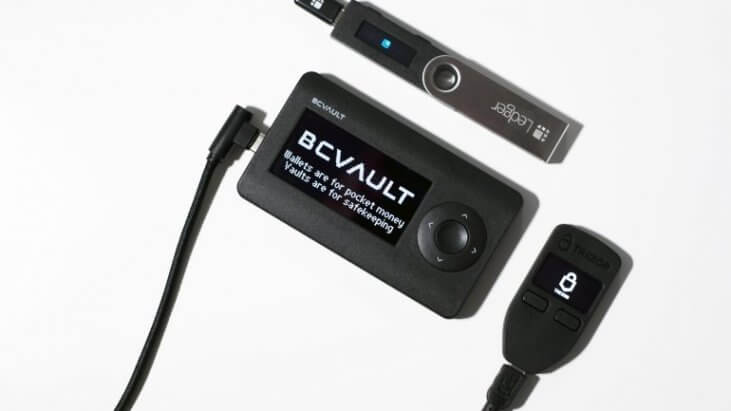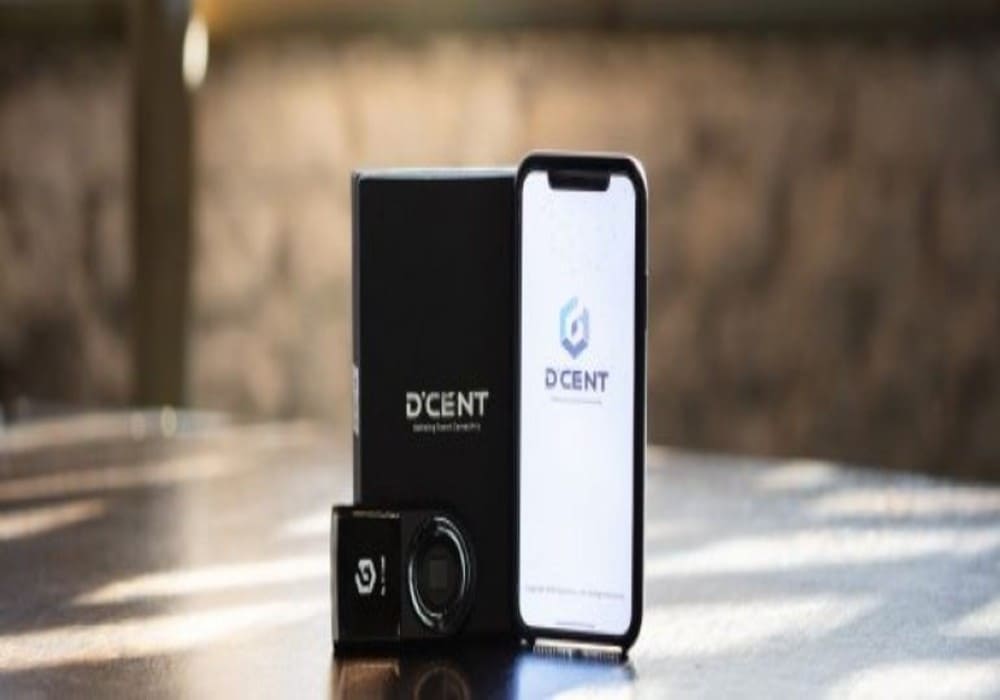Designed by Real Security, a Slovenia-based firm, BC Vault (short for Bitcoin Vault) is a relatively new hardware wallet that provides you with a safe way to store your cryptocurrencies. It is one of the most unique and most innovative hardware wallets we have come across. It seeks to replace some of the most common aspects of a hardware wallet with more secure and highly innovative features.
For instance, instead of recovery seeds, the wallet presents its users with 4-layer security passwords. Similarly, instead of relying on the hierarchical deterministic protocol used in generating new secure wallet addresses, BC Vault adopts the non-deterministic security protocol.
In this BC Vault review, we will be exploring the different operational and security features that help BC Vault stand out of the crowd. We will look at its key features, security features, ease of use, customer support, compare it to other hardware/software wallets and everything else you need to know about the Bitcoin wallet.
We start with key operational features:
BC Vault key features
Large D-pad and display:
The hardware is specially designed with a 2.42-inch OLED that features a 128×64-pixel white-on-black display. The screen is large enough to fit all details of a crypto transaction, including the recipient’s addresses, fees, crypto amount, and the wallet name.
Supports 2000+ wallets:
BC Vault is the truest form of a multi-signature hardware wallet as it allows you to create 2000+ individual wallets. Additionally, the wallet makes it possible for you to create highly unique multi-character passwords for each of these wallets, making it possible to share the device between two or more persons.
Compatible with multiple operating systems:
Like most other hardware wallets, BC Vault has to be paired with a desktop app or browser extension. But unlike most other wallets that will only support a limited number of browsers or operating systems. BC Vault is highly versatile.
Multi-currency support:
According to the BC Vault website, the company currently supports up to 30 cryptocurrencies and tokens. These include all the popular cryptos like Bitcoin, Ethreum, Litecoin, Dogecoin, Ripple, Bitcoin Cash, Litecoin, Bitcoin Gold, Ethreum Classic, all ERC-20 tokens. And with every successive upgrade, the wallet developers promise to add even more coins and tokens.
Native ERC20 token and multi-crypto support
The hardware wallet enables the use of cryptocurrencies in multiple wallets all in a single app. It supports native storage of ERC-20 tokens and does not rely on websites or third-party applications. Users can comfortably manage BCH, LTC, BNB, DASH, and many more supported currencies.
BC Vault security features
Multiple passwords:
Unlike most other crypto hardware wallets that only have one password unlocking the application, device, and individual wallets, BC Vault is fortified with four passwords for both the wallet device and application. The Global Password is used to unlock the BC Vault application and is entered on the application. The Global PIN is, on the other hand, used to unlock the wallet device. The two give you access to both the app and the wallet device.
There’s also the Wallet password that’s used to unlock the wallet on the application. The wallet PIN, on the other hand, is used to unlock a wallet and initiate a transaction and is entered on the wallet device.
Note that the wallet password and pin can be different for each wallet, especially if it is a shared wallet. Plus, it isn’t mandatory that you set the wallet password and PIN if it isn’t shared (not recommended).
Two-factor authentication:
The BC Vault user has the option of activating the two-factor authentication that comes in handy when unlocking the wallet and accessing the wallet content. You can use any of the common two-factor authentication apps /tools like Google Authenticator.
Independently generated keys:
BC Vault uses a Random Number Generator (RNG) to create more than 2000 independent and non-deterministic crypto wallets. What’s more, each key is generated independently, which also means that keys are not mathematically linked.
Secure storage:
All its private keys are stored in specialized storage known as FRAM. They are 1000x faster and consume 250x less power. Apart from that, the hardware is designed with a security chip to prevent the exposure of users’ wallets to hackers or malicious malware.
High anonymity:
The fact that wallets on the hardware device are generated independently enhances its anonymity. Additionally, BC Vault does not have a serial number to ensure complete anonymity of its users’ wallets.
Secure encryption:
Also known as the bounty wallet, this hardware integrates quite a strong encryption. Private keys correspond to a specific public address in each BC Vault.
Industry-standard encryption:
In addition to the passwords, every aspect of the BC Vault hardware wallet is highly encrypted, especially the private keys, your personal data, and the wallet addresses.
SD Card and paper QR backup:
While most crypto hardware wallets available today have recovery seed that one can use to recover private keys if their device is compromised, BC Vault presents you with a 1GB SD Card. It is highly encrypted and provides you with more than enough room for backing up your private keys.
Guaranteed security:
BC Vault touts its wallet as being the most secure cryptocurrency hardware wallet. As a guarantee, the wallet developers have placed a 1BTC price for anyone who will be able to crack the wallet’s encryption.
Tamper proof:
The compact design of the wallet’s hardware ensures that the user will always know when their device has been opened up. Additionally, the software/firmware technology applied in proprietary and not open-sourced, which means a hacker would have to undertake the painstakingly long and tedious process of reverse-engineering the system if they were to carry out a successful hack.
How to set up and activate the BC Vault wallet
Step 1: Plug in the device to your laptop or desktop
For the device to be operational, you have to plug it to a desktop or computer. It has a long connectional cable, which means that you can use it while still connected to the laptop.
Step 2: Shake the device to generate a random number
To generate a wallet address, you are required to shake the device for about two minutes. This is a security safeguard and the non-deterministic form of generating wallet addresses.
Step 3: Download and install the app
After generating the wallet, open the BC Vault official website and download the BC Vault app and link it to your device and the newly-created address. The app is compatible with Windows, macOS, and Linux Operating systems.
Step 4: Set a Global password or PIN
After going through all the above steps, you will be required to set a unique 8-character global password or PIN before you can be allowed to use your BC Vault. It is a fundamental security feature that will be used every time you need to access your BC Vault or application.
Step 5: Create a wallet and transfer funds
Now that you have set your PIN, you need to create a wallet and transfer some crypto funds. You can deposit into your new wallet from another wallet, from an exchange, or by converting your fiat currency via such third party fiat-to-crypto conversion sites like Simplex or Changelly.
Step 6: Use your BC Vault
Now your BC Vault crypto hardware wallet is all set and ready for use.
How to add/receive into your BC vault hardware wallet
Step 1: Start by logging into your wallet device and application, and clicking on the ‘Add New Currency’ tab.
Step 2: Click on the wallet address for the crypto you wish to receive. If it is a new wallet, you will first need to create a new wallet address for the cryptos by simply clicking on ‘New Wallet’ and selecting the crypto you wish to add from the drop-down menu.
Step 3: Copy the wallet address and send it to the party from whom you wish to receive the cryptos or have them scan your address QR Code.
Step 4: Wait for the coins/tokens to reflect in your wallet.
Step 5: Back up your wallet using the SD Card as soon as you add these cryptos into the wallet. Keep in mind that the wallet does not have a cloud backup, and you, therefore, need to backup your wallet on to the SD card every time you load new crypto.
How to Send Funds with Your BC Hardware Wallet
Step 1: Start by launching the BC Vault app and connecting the hardware device
Step 2: Tap on the ‘Send’ icon and click on the cryptocurrency you wish to send.
Step 3: In the pop-up window that appears, key in the recipient’s wallet address and the amount of crypto you wish to send
Step 4: Confirm that the crypto amounts and the wallet address are safe and hit send.
BC Vault wallet costs and fees:
There are currently three models of the BC Vault hardware wallet. The Legendary BC Vault One costs $155, the limited edition of both BC Vault Quicksilver, and BC Vault Gunmetal vaults cost $260. They all have similar specifications safe for Quicksilver and Gunmetal wallets whose casings are made from brushed aluminum and aircraft-grade aluminum, respectively.
Storing your digital assets in the sturdy hardware wallet is free. But you will have to part with variable transaction fees every time you send cryptocurrencies to another wallet or exchange. The amounts charged will depend on the transaction volume and the type of crypto and will go to blockchain miners.
BC Vault wallet customer support:
BC Vault has one of the most elaborate FAQ pages. This section of their website addresses all of the most common challenges by the hardware wallet users. It features both quick-start guides and video tutorials on how to interact with the hardware device. For more personalized queries, however, you may contact the BC Vault hardware wallet developers via email: [email protected] or on their different social media pages.
What are the Pros and Cons of BC Vault Hardware Wallet
Pros:
- It’s a true multi-signature wallet that supports 2000+ individual wallets with unique passwords.
- The wallet integrates some of the most innovative security features that include four sets of passwords and an SD card backup.
- BC Vault wallet has a straightforward activation process and elaborate FAQ Section that make it beginner-friendly
- All aspects of the wallet are highly encrypted to guarantee maximum security.
Cons:
- One may consider BC Vault’s acquisition cost of $155-$260 exorbitant.
- One may question the transparency and security of the wallet, given that their technology isn’t open sourced.
- Doesn’t have a mobile app and doesn’t support Bluetooth/wifi connectivity
How Does Bitcoin Hardware Wallet Compare with Other Wallets?
Unlike Ledger Nano S or Trezor, BC Vault utilizes an encrypted backup and a global password or PIN instead of an unencrypted BIP39/44 seed phrase in its security. Users can also back up their funds externally on a wallet data on an SD.
Further, they can also use an encrypted wallet data to print out a series of QR codes. The majority of their competitors use hierarchical deterministic wallets, which also means that addresses used can be traced back to the seed.
Verdict: Is Bitcoin Vault Worth Your Money?
Based on the security incorporated in these devices, there is no doubt Bitcoin Vault is worth every penny. The device is specially designed to provide users with a sophisticated method to store funds and other digital assets over a long period. Some of the factors that make BC Vault stand out are its adoption of highly unconventional operational and security features.
It, for instance, is the first hardware wallet to forego the recovery seed in favor of an SD card backup. There also aren’t many hardware or software wallets that have as much as four passwords. And while most multisig wallets support multiple wallets, only a few support individualized passwords for each wallet.


